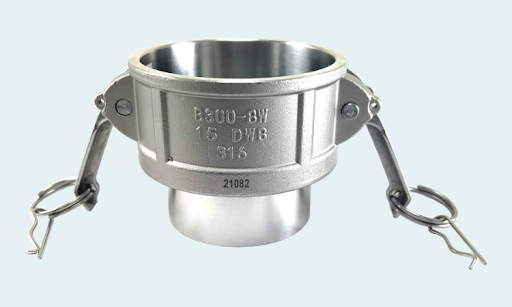Camlock fittings, also known as cam and groove couplings, are an essential component for various industrial applications. These fittings provide a quick and efficient means of connecting and disconnecting hoses and pipes without the need for tools. This versatility makes them a popular choice in the agriculture and petroleum industries. In this blog, we will take an in-depth look at the different types of 3″ camlock fittings, their unique features, and their specific applications.
Understanding Camlock Fittings:
Before we dive into the details of different types of camlock couplings, you must understand what these fittings basically are and how they work. Camlock fittings consist of two main components: the male adapter (also known as the plug) and the female coupler.
The coupler has arms, or cams, which lock into place on the adapter, creating a secure and leak-proof connection. You will also find a wide range of sizes in these fittings, like 4″ camlock fittings, fitting, and more. While this was about the size of cam fittings, you might know that they also have a specific design.
The design of the cam fittings allows for easy installation and removal. This makes them ideal for situations or environments where hoses and pipes need to be frequently connected and disconnected. Many industries use these fittings but some prominent ones are:
– Chemical and petroleum transfer
– Water and wastewater management
– Food and beverage processing
– Agriculture
– Manufacturing
Different Types of Camlock Fittings
Camlock fittings come in various types, each designed for specific applications. Here is a closer look at the different types:
Type A Camlock Fittings
Type A camlock fittings feature a male adapter with a female NPT (National Pipe Thread) connection. The male adapter can quickly connect to a female coupler, while the NPT thread allows for a secure connection to pipes or hoses with corresponding threads.
Applications:
– Chemical Transfer: Ideal for connecting hoses to tanks or containers in chemical plants.
– Water and Wastewater Management: The Type A fittings connect hoses to pumps and other equipment.
– Food and Beverage Processing: They are suitable for sanitary applications. That’s because these applications require quick disconnection for cleaning.
Type B Camlock Fittings
The second promintnent type of fitting you will find is Type B. The Type B camlock fittings consist of a female coupler with a male NPT connection. The female coupler can connect to a male adapter, while the male NPT thread can attach to pipes or hoses.
Applications:
– Petroleum Transfer: They are commonly used in refineries and fuel distribution systems.
– Agriculture: It is very useful for irrigation systems where hoses need to be frequently moved.
– Manufacturing: These fittings are employed in processes that require quick hose changes for different production lines.
Type C Camlock Fittings
Coming to the third type, Type C, these camlock fittings have a female coupler with a hose barb end. The female coupler connects to a male adapter, and the hose barb end allows for a secure connection to hoses using clamps.
Applications:
– Water Transfer: It is widely used in firefighting and water delivery systems.
– Food and Beverage Processing: They are suitable for connecting hoses to tanks and transport vehicles.
– Agriculture: Type C fittings are also used to connect hoses in irrigation and fertilization systems.
Type D Camlock Fittings
Type D camlock fittings feature a female coupler with a female NPT connection. The female coupler connects to a male adapter, and the female NPT thread attaches to pipes or hoses with male threads.
Applications:
– Chemical Transfer: It is used to connect hoses to storage tanks in chemical plants.
– Petroleum Transfer: They are suitable for connecting hoses to fuel tanks and distribution systems.
– Water and Wastewater Management: They are employed in treatment plants for easy hose connections.
Type E Camlock Fittings
Type E camlock fittings consist of a male adapter with a hose barb end. The male adapter connects to a female coupler, and the hose barb end attaches to hoses using clamps.
Applications:
– Water Transfer: It is ideal for firefighting and water delivery systems.
– Food and Beverage Processing: They are suitable for transferring liquids in sanitary applications.
– Agriculture: irrigation and fertilization systems use these fittings to connect hoses.
Type F Camlock Fittings
Type F camlock fittings have a male adapter with a male NPT connection. The male adapter connects to a female coupler, and the male NPT thread attaches to pipes or hoses with female threads.
Applications:
– Chemical Transfer: They are commonly used in chemical plants to connect hoses to tanks and containers.
– Petroleum Transfer: Type F fittings are suitable for fuel distribution systems in refineries.
– Water and Wastewater Management: They are mainly employed in treatment plants for secure hose connections.
Type DC Camlock Fittings (Dust Cap)
Type DC camlock fittings are dust caps design fittings that help to cover the end of a male adapter. They prevent contamination and damage when the fitting is not in use.
Applications:
– Chemical Transfer: It protects male adapters from contamination in chemical plants.
– Petroleum Transfer: This fitting prevents dirt and debris from entering fuel distribution systems.
– Food and Beverage Processing: It also helps maintain sanitary conditions by covering unused male adapters.
Type DP Camlock Fittings (Dust Plug)
Last but surely not the least, type of camlock fittings is Type DP. These fittings boast a dust plug design that helps to cover the end of a female coupler. They protect the coupler from contamination and damage when not in use.
Applications:
– Chemical Transfer: It keeps female couplers clean and free from contaminants.
– Petroleum Transfer: Type DP fittings prevent debris from entering fuel distribution systems.
– Food and Beverage Processing: These fittings also ensure sanitary conditions by covering unused female couplers.
Conclusion
Camlock fittings are versatile and essential components in a wide range of industrial applications. Each type of camlock fitting has unique features and specific uses that make them suitable for different industries and processes. Understanding the different types and their applications can help you choose the right camlock fitting for your needs, ensuring a secure, efficient, and leak-proof connection.
Whether you are in the chemical, petroleum, water management, food processing, or agricultural industry, camlock fittings can provide the quick and reliable connections you need to keep your operations running smoothly. By selecting the appropriate camlock fitting type, you can enhance the efficiency and safety of your processes, contributing to overall operational success.




